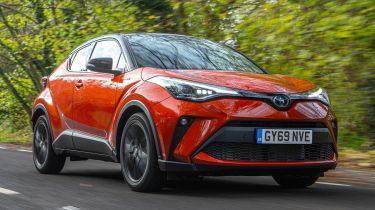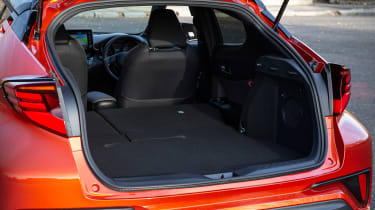Toyota C-HR (2016-2023) review - Practicality, comfort and boot space
The C-HR offers more space than you might think, although it's still not as practical as some of its conventional rivals

The C-HR does a good job of disguising its size, with its sleek coupe proportions making it appear more compact than it is. In reality, the C-HR occupies the same footprint as models such as the Nissan Qashqai and SEAT Ateca. That said, the Toyota’s style doesn’t come without compromise, and the C-HR isn’t as practical as more conventional crossover rivals.
Inside, there’s decent legroom in the rear and a surprising amount of headroom given the sloping roofline. Access is fairly straightforward, because despite its coupe looks the C-HR benefits from a five-door layout, with the rear door handles set into the window frames. The rear doors feature a wide opening, and only taller occupants will find the low roof a bit of pain when lowering themselves in.
The boot is roomy and well-shaped, but is closer in size to a compact family hatchback’s than its traditional crossover rivals’. Still, the C-HR has a large tailgate opening and it’s easy to load items despite the lip.
Upfront, the driver and passenger get plenty of space and seat adjustment. You sit slightly higher than in a traditional hatchback, while the low dashboard and large windscreen give a panoramic view out.
Used - available now

2024 Toyota
Yaris Hybrid
29,279 milesAutomaticPetrol1.5L
Cash £17,452
2021 DS
DS 3 CROSSBACK E-TENSE
21,684 milesAutomaticElectric
Cash £11,414
2020 Peugeot
3008
38,095 milesManualDiesel1.5L
Cash £12,299
2025 Toyota
Yaris Hybrid
8,232 milesAutomaticPetrol1.5L
Cash £15,750As you’d expect of a car aimed at families as well as younger buyers, there’s plenty of handy cubby space. The front door bins are large and will comfortably accommodate half-litre bottles, there’s a large glovebox and a deep, lidded container between the front seats. There’s also a trinket tray ahead of the gearlever that’s perfect for smartphone storage.
Size
In terms of its external dimensions, the C-HR is close in size to the previous-generation Nissan Qashqai, but shorter than a VW Tiguan. The Toyota’s sleek lines fool the eye into thinking it’s a more compact model like the Nissan Juke.
The five-door body means access to the C-HR is straightforward, while forward visibility from the driver’s seat is excellent. It’s less impressive in the rear, where the thick C-Pillars force occupants to lean forward if they want to see out. Visibility out of the back window is acceptable, although the rising window line and thick pillars mean you can’t see much when checking your blind spot to change lanes. This is where the standard-fit reversing camera really helps during manoeuvres.
Legroom, headroom and passenger space
The vast C-pillars and small rear windows mean that occupants in the back of the C-HR will feel quite claustrophobic. However, get the tape measure out and you’ll find that the Toyota is on par with the Nissan Qashqai for legroom, while the high set front seats means there’s plenty of space to tuck your feet under.
By placing the base of the rear bench low, Toyota has also created a surprising amount of headroom. And while the rear bench isn’t as wide as some rivals, there’s just enough room for adult passengers.
Boot
Open the C-HR’s large tailgate and you’ll discover a usefully shaped load bay that’s free of awkward intrusions. At 377-litres it’s a decent size according to the standards set by regular compact hatchback models, but it significantly trails the SEAT Ateca’s 485-litre load bay.
The C-HR also lacks some of the clever storage features we’ve come to expect from crossover models. There’s a small amount of storage space underneath the boot floor, but that’s about it.
Still, a 60/40 split/fold rear seat is standard, which helps boost the Toyota’s versatility. The seats are folded by releasing handles on top of the seatbacks, which releases a useful 924-litre flat loading bay.
Towing
If you're prioritising towing ability then you may need to look elsewhere, as both the 1.8 and 2.0-litre C-HR models have a maximum braked trailer weight of just 725kg.










